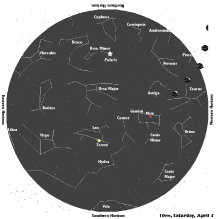Tracking the New Moon
You may not see it, but a lot of people rely on it just the same

The last of the waning winter moon rises before dawn Friday morning. You may need binoculars to spot this ever-so-thin crescent rising above the eastern horizon just before 6am. As the moon climbs higher with the onset of morning twilight, scan the horizon for Venus, which trails the moon by about six degrees. As the two climb higher, they fade with the approach of sunrise at 6:47.
All new moons pass, Saturday’s included, directly between the Earth and sun, so that it is invisible here on terra firma. From a layman’s point of view, new moon occurs when the first visible crescent reemerges from the sun’s glare. By such a definition, the time and even date of new moon, and the other phases as well, would change from place to place. Were that the case, with the moon from our vantage still obscured by the sun’s glare Sunday, new moon would be Monday, when a thin sliver appears above the west horizon just after sunset at 7:38.
Such a definition may have worked centuries ago, but not in the fast-moving, small world of today. Not only does science need consistency, but many religions and cultures depend on new moon. Muslims, Jews, Hindus, Buddhists and the Chinese follow a lunar calendar, and new moon marks the beginning each new month.
So astronomers rely on the ecliptic, the path along which the sun, moon planets and zodiacal constellations travel. While the ecliptic may be an imaginary line, a contrivance seen from our Earth-bound vantage, it is nonetheless a stationary line. And so new moon falls when both sun and moon conjoin along the ecliptic.
Tidelog®
Illustration: © Copyright 1925 M.C. Escher/Cordon Art-Baarn-Holland; Graphics: © Copyright 2007 Pacific Publishers. Reprinted by permission from the Tidelog graphic almanac. Bound copies of the annual Tidelog for Chesapeake Bay are $14.95 ppd. from Pacific Publishers, Box 480, Bolinas, CA 94924. Phone 415-868-2909. Weather affects tides. This information is believed to be reliable but no guarantee of accuracy is made by Bay Weekly or Pacific Publishers. The actual layout of Tidelog differs from that used in Bay Weekly. Tidelog graphics are repositioned to reflect Bay Weekly’s distribution cycle.Tides are based on National Oceanic and Atmospheric Administration and are positioned to coincide with high and low tides of Tidelog.